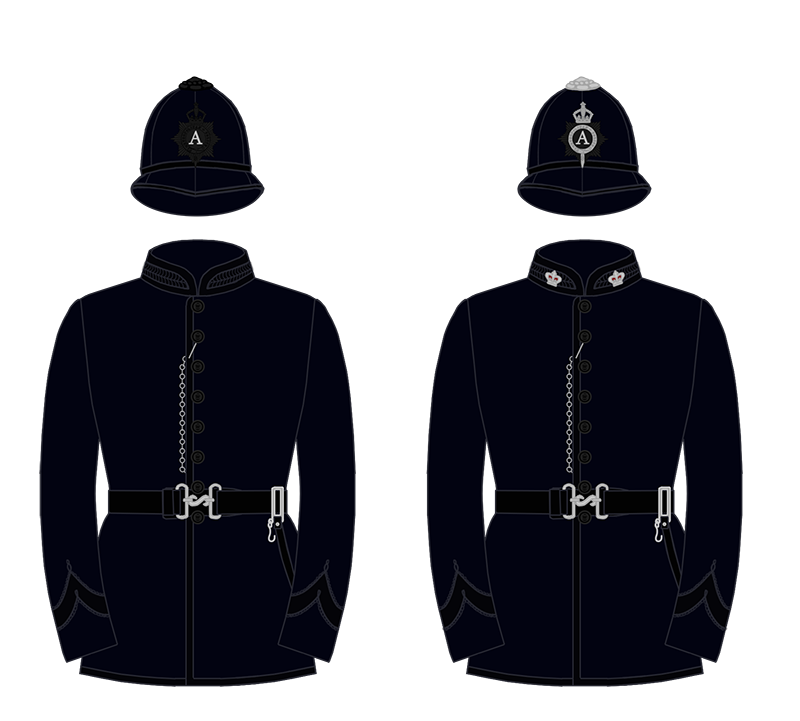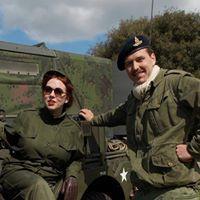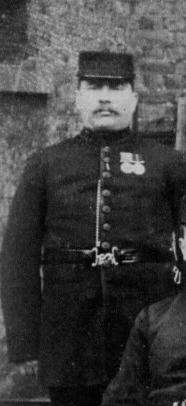-
Posts
70 -
Joined
-
Last visited
Content Type
Profiles
Forums
Blogs
Gallery
Events
Store
Posts posted by SimonLMoore
-
-
Hey chaps, first I'd like to say this project is not dead, just that I have come up against a bit of a brick wall finding out more information, particularly regarding specific dates, I hope re-opening this thread might turn up some more information. The main issue I am having is with the various grades of Inspector's uniform, circa 1870-1886.
Below are two illustrations I've done to show the issues I'm having, the top example is based on information in the 'Behind the Blue Lamp' series and the famous Vanity Fair caricature of Chief Inspector Ebenezer Denning with an accompanying painting of the Lobby of the House of Commons from 1886.
Both these sources show Chief Inspectors wearing a uniform as shown on the right, the helmet plate is known to be correct as is the silver embroidery on the tunic, an extant example in a photograph posted elsewhere on this forum seems to have blackened brass buttons but period photos seem to show bright metal buttons (transitional?). In both sources the rosette atop the helmet appears to be bright not blackened though I would be happy to be corrected on this if it is wrong.
The Inspectors uniform on the left has a question mark hanging over it, the helmet plate is known to be correct, should the rosette atop the helmet be bright not blackened? Is the lack of the silver embroidery to the cuffs correct as a way of identifying the two ranks?
Finally were these uniforms the predecessors of the examples shown in the second image or worn as every day uniform or did they exist concurrently but as a dress uniform?

The second illustration, below, shows two uniforms known to be largely correct, the tunics at least, the helmet details have the same question marks as raised above. The questions I have are, when was this sort of tunic introduced (possibly around 1886, the famous group photograph of H Division from around this time, posted earlier in this thread by Zeb seems to show Inspectors wearing this plainer uniform but with kepis, hoping to get a clearer version of the photo at some point.) And when did Chief Inspectors receive the crown on the collar to denote their rank? As I understand it Sub-Divisional Inspectors were identified by a star on the collar from the introduction of the rank in 1887 so it is possible the crown also came into use at this time?

Any help much appreciated, information has otherwise dried up and I am alas too far North to head to the Metropolitan Police Heritage Centre for the foreseeable future.
0 -
I hope you don't mind me re-opening this thread but it follows on from the discussion of dress swords above, there is an excellent 2012 photograph of the City of London Police Commissioner on horseback with a ceremonial sword adorned with a gold sword knot with a darker thread (blue?) interwoven, rather like those used by Royal Navy officers. https://upload.wikimedia.org/wikipedia/commons/e/e0/Mounted_Police.JPG
Obviously the City force is an exception, I'm assuming other forces with white rather than yellow metal buttons insignia etc. would have a silver sword knot if any for the most senior officers? Photographs seem to show this for the Met, brilliant photo of Colonel Sir Edward Bradford with "Metropolitan Police Commissioners' ceremonial sword, cavalry pattern with mameluke hilt." http://lafayette.org.uk/bra2660.html#N_1_
I've seen some excellent photos of Superintendents in the Met wearing (presumably black) leather Army style knots with their ceremonial swords, circa 1890s,early 1900s. There are certainly extant photographs of Inspectors wearing ceremonial swords into the 1910s but they do not appear to wear sword knots.
I'd be interested to know know more about ceremonial Police swords, knots and scabbards if anyone has any further information or can direct me to a source!
0 -
Nice, I wonder if has it been used as a dockyard plate at some point, wondering if the large holes are to attach the skewed fouled anchor.
0 -
Thanks very much for the info Mervyn!
0 -
-
Hey chaps, I'm hoping someone on here will be able to assist me in answering a question which has, sort of been asked on here before but not coherently, I now have the information I need to ask the specific question and it regards Metropolitan Police Inspectors/Chief Inspectors uniform circa the 1880s as this seems to be around the date of changeover, if there is one.
Basically there are two patterns of tunic to consider one with 'silver' buttons and silver wire embroidery to cuffs and collar and the other more familiar with black buttons and trim. What I am trying to ascertain is was the latter a replacement for the former and if so when did this take place or were they worn concurrently with the silver buttoned and embroidered tunic as dress uniform.
I have seen a photograph of H Division prior to 1888 which shows the tunic without silver embroidery and with black buttons being worn hence my thoughts on the date of changeover.
0 -
Nice to see myths being perpetuated by the BCC, the 7 trouser creases do not represent the 7 seas. Indeed if you were under a certain height (5' 6" I think) you only had 5.
Edit; wow, seems that graphic is put out by the RN itself. They don't seem to know their own history. The 3 stripes are also nothing to do with Nelson's victories, some original collars had only 2 and it was decided with the introduction of a uniform for all sailors in 1857 that 3 looked better, smarter, etc. It's not naval folklore, it's landlubber's folklore that's grown up around the uniform well after the fact.
0 -
Any errors please let me know, I hope you find this interesting!
0 -
-
Smock and Trousers, Combat, 1968 Pattern
The first really major deviation from the combats introduced druing the Korean war, the 1968 pattern sees quite a bit of simplification, the elbow patches are gone from the smock, as is the stitched collar, the back seam is gone and there are other small detail differences. The trousers have lost the knee pads which ran as a double-thick layer around the centre part of the leg in previous patterns but a second map pocket was added to the right leg. No label for the trousers as again it's been removed
Smock, Combat, 1968 Pattern
Trousers, Combat, 1968 Pattern
0 -
Smock and Trousers, Combat, 1960 Pattern (DPM)
The 1960 pattern made in DPM, this uniform was first manufactured in 1966 and is thus sometimes referred to as '1966 pattern' by collectors. No label photo for the smock as it has sadly been removed.
Smock, Combat, 1960 Pattern (DPM)
Trousers, Combat, 1960 Pattern (DPM)
0 -
Smock and Trousers, Combat, 1960 Pattern
The 1960 pattern standardised the existing combat uniform for general issue to replace the then still extant 1949 pattern battledress. Buttons were no longer vegetable ivory but of hard green plastic, these were first seen on late-issues of the combat sateen uniform.
The smock differs from the previous pattern in having rounded elbow patches, rather than large, square patches. The trousers differ little from the 1953 pattern.
The material is a coarser weave than the very fine sateen material seen in the earliest pattern of combats, this material started to be used in later manufacture of the Smock, Combat, Sateen and the Trousers, Combat, 1953 Pattern, as with most uniform changes in material came in gradually, across official pattern designations.
Smock, Combat, 1960 Pattern
Trousers, Combat, 1960 Pattern
0 -
Smock and Trousers, Combat, Sateen
Several patterns here, the first issue being the Smock, Combat, Sateen and Trousers, Combat, Sateen, sometimes referred to as '1950 Pattern' the smock remained largely unchanged, the trousers went through two other patterns, 1952 and 1953 pattern. The 1952 pattern deleted the button flap over the zip fly and slanted the side pockets, the 1953 pattern basically combines the simplified fly of the 1952 pattern with the original pocket layout from the Trousers, Combat Sateen.
Smock, Combat, Sateen
Trousers,Combat, Sateen
Trousers, Combat, 1952 Pattern
Trousers, Combat, 1953 Pattern
0 -
A little while ago I promised to create a thread detailing British combats from the Korean War to 1968 pattern so here it is, details in the following messages, I've largely let the photos speak for themselves. Sorry the label photos are sometimes a bit fuzzy, I will endeavour to replace these at some point and sorry for those where the labels are almost completely washed out.
0 -
Well I bought it with two other jackets, another SD tunic from the 20s and a 1928 dated blues tunic, all to the same chap, only discovered the date in this afterwards! The reason for the purchase was originally that it should fit and they were something of a bargain.
0 -
Thanks for the replies, he's definitely City Police but as you say Mervyn they look very much like Met buttons.
As far as I know these are the official pattern of buttons for Inspectors and above in the City of London Police, even at this early date;
 0
0 -
Thanks for showing. I've not seen the "T" below the Ubique grenades before.
Glad it was of interest. I rather thought the collars for TF RA Officers gained the 'Ubique' at the same time as the cap badge, in 1917. I believe the Ts, in contrast, were regulation until 1940. Happy to be corrected but that was my understanding, not saying as gospel as I sadly don't have access to my reference books to double check right now.
0 -
Hi Chaps, been on a hiatus from the forum for far too long, I thought I'd make a return by posting up some photos of a recent acquisition, a 1918 dated RA Territorials Officer's tunic, rather interesting as it's made to an off-the-peg size. In rather nice condition for it's age.
http://gmic.co.uk/uploads/monthly_03_2015/post-17470-0-04534600-1425323122.jpghttp://gmic.co.uk/uploads/monthly_03_2015/post-17470-0-78917100-1425323096.jpghttp://gmic.co.uk/uploads/monthly_03_2015/post-17470-0-48108900-1425323095.jpghttp://gmic.co.uk/uploads/monthly_03_2015/post-17470-0-09665400-1425323071.jpghttp://gmic.co.uk/uploads/monthly_03_2015/post-17470-0-85916000-1425323097.jpghttp://gmic.co.uk/uploads/monthly_03_2015/post-17470-0-97367500-1425323098.jpg
0 -
Firstly, hello again after a very long hiatus!
Thought I'd begin my return by sharing an old cabinet card here which I have shown before, cropped. However I noticed on zooming in the buttons are a bit odd, as far as I am aware. I understand the City Police senior officers had and indeed still have buttons bearing the City of London coat of arms whereas this chap has a St. Edward's crown in the centre and a scroll surrounding.
The cap badge and other details certainly indicate a City of London Police Inspector.
Any help much appreciated.
http://gmic.co.uk/uploads/monthly_03_2015/post-17470-0-48499900-1425322287.jpghttp://gmic.co.uk/uploads/monthly_03_2015/post-17470-0-88581300-1425322289.jpg
0 -
Excelent displays Simon. What is the helmet next to the white top visor, a tankers lid? Any chance of some detail pics of the headgear?
Sure thing once I have a working camera again! It is indeed a tankie's helmet, they were used by the RN from the '40s through the '80s early '90s.
0 -
It's hard to tell from the photos, is the top plastic or whitened canvas?
0 -
Absolutely marvellous details thank you so much Peter!
Dare I ask what form did the Superintendent's helmet plate take, the illustration in my first post shows the plate but it is difficult to discern the level of bright vs. blackened metal.
0 -
Thanks for these Mervyn!
0 -
To confirm the IWM is incorrect for the 1960 Pattern DPM introduction date, it was 1966, hence it's unofficial name of '1966 Pattern' I mentioned earlier.
0






Police Uniform Illustrations **RECOMMENDED
in Great Britain: Mervyn Mitton's British & Colonial Police Forces
Posted
Happy to say I've managed to find an answer to part of my question, it seems the silver braided uniform was in use until 1887 as a dress uniform when the undress tunic replaced it for use as the dress uniform too. Still looking for details on the helmets and whether both Inspectors and Chief Inspectors wore the silver leaf embroidery on the cuffs.